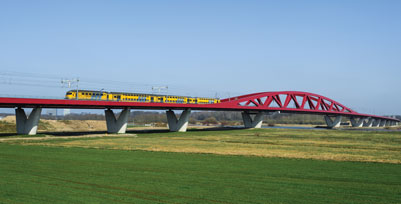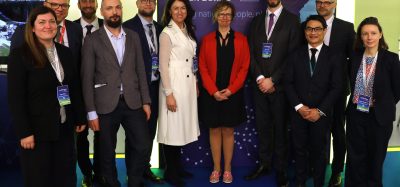Creating a ‘Green Wave’ on the Dutch railways
Posted: 12 February 2014 | | No comments yet
Forty different users and 3.3 million train movements. Every year, creating a master plan for capacity allocation on the busiest rail network in Europe poses a formidable mathematical challenge for the Dutch rail infrastructure management company ProRail. How does ProRail address this operational challenge in a way that is compatible with its ambitions for the future: record levels of safety, capacity growth, a well-maintained rail network and robust connections with the rest of Europe? For Global Railway Review, Hugo Thomassen, ProRail’s Director of Transport and Timetables, explains the Dutch approach to these matters.


Every year, creating a master plan for capacity allocation on the busiest rail network in Europe poses a formidable mathematical challenge for the Dutch rail infrastructure management company ProRail
To understand the challenges we face in the Dutch railway sector, it may be instructive to start with a brief overview of the unique environment we operate in. The Netherlands is the most densely populated country in the European Union, with 16.8 million inhabitants. Mobility is very high in our flat country, partly thanks to the high rail density: our network consists of 7,033km of track, reaching all corners of the country. It contains 2,731 level crossings (1,614 of which are protected by automatic barriers), 7,195 points and 11,683 signals. Within the network, there are also 725 railway viaducts, 455 railway bridges, 56 moving bridges, 17 tunnels and 404 railway stations.
In the Netherlands, management and maintenance of the rail infrastructure was separated from operating trains just over 10 years ago. ProRail is owned by the State of the Netherlands and has been put in charge – by the Ministry of Infrastructure and the Environment – of the development, maintenance and management of the rail network and stations, including capacity allocation and overall network safety.
ProRail has set itself some very ambitious goals. An even safer and more reliable railway – with zero avoidable accidents and disruptions – features prominently at the top of our list of strategic objectives. In addition, we aim to further improve punctuality and to work in a more sustainable, environmentally-friendly way. To be specific, we aim to reduce our energy consumption by 20% and thereby to reach the highest rung of the CO2-Performance Ladder. Our ambitious change programmes are already putting us on course to make great progress towards these goals.
Green Wave
These objectives have to be considered in the context of an ever-increasing demand for rail capacity. For instance, we need to integrate more (and more sophisticated) safety mechanisms while at the same time developing more track and accommodating more train movements. If that seems like a complex puzzle, then that is because it actually is! One thing is very clear however: the foundations need to be sound. We want to implement a ‘Green Wave’ on the Dutch rail network, meaning that – even on the busiest sections – no train has to wait for a red signal unnecessarily. This ticks all the boxes: it increases safety and punctuality as well as sustainability.
Our capacity allocation process is a good example of these sound foundations. Being an impartial network manager, it is our responsibility to allocate access to Europe’s busiest rail network as fairly and optimally as possible. A challenge that we at ProRail find equally appealing and complex, since the capacity constraints do not put a stop to the growing demand for network access, both from passenger and freight carriers.
Distribution Roundtable
So how do we do that? Together with the 40 passenger and freight carriers who wish to use the Dutch rail network, we have developed an unconventional approach. This model aims for optimal distribution of network capacity. We only have one railway system and we jointly need to find a way to put it to best use. You could say that our ‘Distribution Roundtable’ is a typically Dutch approach to such a challenge: it creates a level playing field for all participants and aims for an outcome based on consensus.
The process consists of seven steps. The first step is about solving the network puzzle for a typical, representative one-hour slot. This is completed a year and a half before the timetable has to be operational. For this one-hour period, we determine which combination of movements – in terms of frequency and types of trains – can be accommodated on each section of the network. This we do in co-operation with the operators.
Alignment
In the next step, each of the operators puts their requirements on ‘the table’. This is facilitated by ProRail’s web application Donna, which supports the capacity planning and allocation process in a very user-friendly way. Through Donna, train movements can be evaluated, modified, planned, requested and granted in a relatively short time.
ProRail co-ordinates this process in a fully transparent way: all participants have access to every other network user’s capacity requests. In cases of conflicting requirements, we investigate if a few minor modifications can achieve a solution that is agreeable to both parties. Parties can also initiate bilateral discussions. At this stage, every participant in the process has the same status. A large international freight carrier? A small party train operator? Or the country’s largest transport company NS, the monopolist for passenger transport on the main line network? Everybody is equal, as long as their capacity requests are sensible.
Naturally, there will be cases when just facilitating the process does not result in a mutually acceptable resolution of conflicting requests. In those cases, ProRail has the casting vote, and makes the final decision on the basis of clear criteria, which are determined by the relevant laws and government regulations, and are also laid down in ProRail’s own, annually updated ‘Network Statement’. Ultimately, a train operator can escalate a conflict to the competent legal authorities, but all our efforts are geared towards reaching an acceptable outcome amongst ourselves. An added benefit of this approach is that it stimulates alignment in other areas too, and instils a spirit of ‘we run the railway together’.
Serious Gaming
In our quest to increase the capacity on the existing network, we don’t just stick to conventional methods. We also pursue innovative solutions, like re-routing and re-timing of scheduled movements, upgrades to the physical infrastructure or alternative usage of that infrastructure. In this context, our unique co-operation with Delft University of Technology deserves a mention. In a joint programme, we have set-up a simulated but realistic environment, where our operational staff can pilot innovations in different scenarios, using the ‘Serious Gaming’ concept. Rather than going on a fact-finding mission together, we are actually determining the facts in this very advanced programme. The results are astounding and save us millions of Euros in development costs.
Solid foundation
One of the main success criteria for the capacity distribution process is the emergence of a smooth timetable without conflicts. For no matter how clever the outcome is, if the staff in the field, such as the train dispatchers, can’t see the wood for the trees anymore, then this has repercussions for punctuality, safety and ultimately for the environment too. Our web application Donna highlights those parts of the timetable where the thousands of daily requested train movements are causing conflicts. This allows us to zoom in on these specific bottlenecks and resolve them at source. In 2014, this kind of conflict monitoring will also be activated for major hubs like Utrecht, which has the highest number of points and shunting manoeuvres. Proper planning is the first layer of safety. Plan the executable and execute the plan – that is our motto. And ProRail will implement some other concrete measures to further increase rail safety in 2014. For instance, we will be expediting the installation of the train safety system ATB-vv. Our training programmes are also always prioritising safety before anything else. Finally, we have decided to carry out maintenance on both tracks of a double-track section at the same time; this means that while maintenance activities are carried out, there will be no train movements in either direction on the relevant section. Previously, we would close down only one of the tracks for maintenance, while using the other track to accommodate train movements in both directions.
Accident brought changes forward
These developments were given increased priority after an accident near Amsterdam on 21 April 2012. This marked a turning-point in our thinking about rail safety. The collision between an Intercity and a Sprinter (stopping) train unfortunately resulted in one fatal casualty and dozens of injuries. The immediate cause was a driver ignoring a red signal. But if you look beyond the immediate cause, it becomes clear that the risk of human error was increased by the fact that the train was using a different track than originally scheduled, due to maintenance activities. So the underlying cause of the accident was the complexity associated with our desire to serve customers and carry out maintenance at the same time. We now try to avoid situations where drivers encounter a red sign when they do not expect it, by introducing the ‘Green Wave’ concept on the Dutch railways we are always looking for the safest routing.
The consequences of this safety-first policy are considerable. Maintenance becomes more expensive, because the time slots available to complete it have become shorter. Contractors have to adopt a very different way of working. The last passenger trains of the day have to be cancelled on sections where maintenance is necessary. For three nights per week, we cannot accommodate the night trains to Schiphol airport anymore. Freight trains have to be re-routed onto longer itineraries when a section is closed down.
High-Frequency Rail Transport Programme
This is why ProRail monitors and evaluates this kind of safety measure very carefully. After all, on top of the intensive track maintenance activities, many of the major stations in the country are also being refurbished, in order to meet the ever-growing demand. And in some strategic places, we are upgrading single-track sections to double-track. How can you keep doing ‘business as usual’ during such fundamental renovations?
The Ministry of Infrastructure and the Environment has commissioned ProRail and the train operators to work on the High-Frequency Rail Transport programme. The essence of this initiative is to prioritise passenger transport on the busiest sections of the network, while concentrating freight transport on the Betuweroute. But before we do that, we will maximise capacity at our main network hubs. Together with the operators, we will first focus on operational reliability, in order to create the additional capacity that will enable higher frequencies. The next major milestone that will help us to realise our objectives is the adoption of the European Rail Traffic Management System (ERTMS).
Biography
Hugo Thomassen is the Director of Transport and Timetables (a.i) and Member of the Board of ProRail. In 1990, Hugo Thomassen started his career as a management consultant at Bakkenist Spits & Co, supporting organisations mainly in strategy development, restructuring and efficiency improvement. His experience covers a wide variety of industries, like Energy, Transport, Healthcare, Electronics and Engineering. In 1997, Hugo joined NS Reizigers, the passenger transport division of the Dutch Railways. Amongst other things, he was responsible for the financial aspects of NS’ bid for one of the UK public transport franchises. In 2000 he became jointly responsible for the design of a new railway strategy, together with the Ministry of Transport and ProRail’s predecessors. In 2003 he took the position of Head of Rolling Stock Development. In 2007, Hugo crossed over to ProRail, where he became Manager Capacity Allocation. In his later years in this position, Hugo worked on a programme that aimed to reinforce the use of timetable planning as a means of preventing train collisions. In 2013, Hugo was appointed to the position of Director of Transport and Timetables on an ad interim basis. Besides capacity allocation, he is now responsible for capacity development and account management. Hugo Thomassen graduated from the University of Groningen with an MSc in Economics. In 1995 he graduated as a Certified Management Accountant from the VU University of Amsterdam.







